
Official Edgar Rice Burroughs Tribute and Weekly Webzine Site
Volume 8087a

Newspapers in the Fiction of Edgar Rice Burroughs II
by Alan Hanson
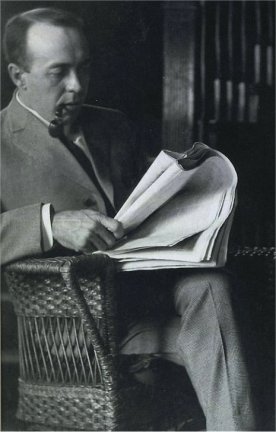
This is Part Two of Alan Hanson's summary of how Edgar Rice Burroughs used the subject of newspapers in his fiction.
Part One covered the topic in ERB's stories written from 1912 to 1923.
Part Two addresses the newspaper theme in his works of fiction written from 1924 through 1940.
NOTE: Each title contains a hot link to my ERB Bibliography in ERBzine ~
Featuring cover & interior illustrations, publishing history, reviews, e-text edition, etc. for each edition
~ Bill Hillman

Sacket
family history
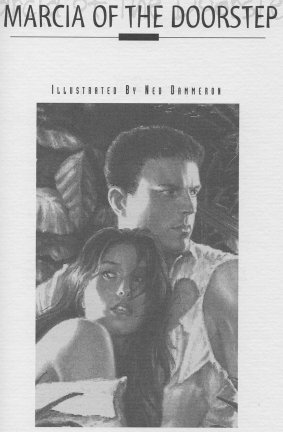
<>
<>Newspapers are a recurring theme in Burroughs’ 1924 saga of the Sacket family. It begins in the story’s opening page. The shyster attorney Max Heimer has been blackmailing John Hancock Chase, Jr., over an allegation that Chase impregnated a woman while drunk. “If you don’t come across with the ten thousand,” Heimer threatened, “I’ll start suit and give the whole story to the newspapers. Rather than pay up, Chase committed suicide. The headline the next day in a New York evening news paper read, SENATOR’S SON KILLS SELF.” When Heimer read it, he felt “cheated” out of the blackmail money.
<>Newspapers are a recurring theme in Burroughs’ 1924 saga of the Sacket family. It begins in the story’s opening page. The shyster attorney Max Heimer has been blackmailing John Hancock Chase, Jr., over an allegation that Chase impregnated a woman while drunk. “If you don’t come across with the ten thousand,” Heimer threatened, “I’ll start suit and give the whole story to the newspapers. Rather than pay up, Chase committed suicide. The headline the next day in a New York evening news paper read, SENATOR’S SON KILLS SELF.” When Heimer read it, he felt “cheated” out of the blackmail money.
<>
<>Later on in the story, young Dick Steele, pining for the loss of his beloved to another man, fantasized of a newspaper headline that would surely make Marcia regret she had chosen the other guy over him.
<>Later on in the story, young Dick Steele, pining for the loss of his beloved to another man, fantasized of a newspaper headline that would surely make Marcia regret she had chosen the other guy over him.
<>
“INTREPID BIRDMAN FALLS TO DEATH: RICHARD
STEELE, JR.,
FAMOUS ACE, DIES ON WAY TO HOSPITAL.”
<>
<>Sometime later, old Marcus Sackett, believing he had lost almost all of a $20,000 stake, prepared to commit suicide. He “returned to the room and fetched several newspapers, some of which he stuffed into the ventilator. Then he closed and locked the door from the inside and fell to work tearing the paper into strips which he stuffed into the cracks around the door. Then he turned on the gas and sat down in the chair.” (His wife came home in time to prevent the suicide.)
<>Sometime later, old Marcus Sackett, believing he had lost almost all of a $20,000 stake, prepared to commit suicide. He “returned to the room and fetched several newspapers, some of which he stuffed into the ventilator. Then he closed and locked the door from the inside and fell to work tearing the paper into strips which he stuffed into the cracks around the door. Then he turned on the gas and sat down in the chair.” (His wife came home in time to prevent the suicide.)
<>
<>Later on, Marcus and Clara Sackett read with concern the following newspaper article.
<>Later on, Marcus and Clara Sackett read with concern the following newspaper article.
<>
<>“Millionaire’s Yacht Missing: The Lady X, owned by Homer Ashton of New York, who has been cruising among the Pacific islands with a party of guests, reported three weeks overdue to Manila.” Marcia, the Sacketts’ adopted daughter, was among the guests on the missing yacht.”
<>“Millionaire’s Yacht Missing: The Lady X, owned by Homer Ashton of New York, who has been cruising among the Pacific islands with a party of guests, reported three weeks overdue to Manila.” Marcia, the Sacketts’ adopted daughter, was among the guests on the missing yacht.”
<>
<>Meanwhile, Jack Chase, another member of the story’s complicated cast of characters, purchased a newspaper in New York City. After finding something in the “Help Wanted” ads, he turned to the sports page. “Let’s see what yesterday’s scores were,” he said to himself, “and then we’ll beat it out to Hollywood and get a job in the movies.”
<>Meanwhile, Jack Chase, another member of the story’s complicated cast of characters, purchased a newspaper in New York City. After finding something in the “Help Wanted” ads, he turned to the sports page. “Let’s see what yesterday’s scores were,” he said to himself, “and then we’ll beat it out to Hollywood and get a job in the movies.”
In the
story’s final reference to newspapers, one
Banks van Spiddle, the novel’s general all-around “good guy,” reads the
headline in the afternoon newspaper: “STUNT AVIATOR KILLED IN MYSTERY
FALL.”
The article revealed that “Dick Steele, stunt aviator for the
Silverscreen
Studio was instantly killed when he fell or leaped from plane at
Crescent Field
yesterday.” Steele’s death cleared the way for Van Spiddle to move in
and marry
Marcia, or so he thought.
<>
Story
based on newspaper article
<>
<>ERB began his story with the following statement concerning a passing newspaper report that could have led to another “terrible world war,” had not Tarzan stepped in to prevent it.
<>ERB began his story with the following statement concerning a passing newspaper report that could have led to another “terrible world war,” had not Tarzan stepped in to prevent it.
<>
<>“Had the story that I am about to tell you broken in the newspapers of two certain European powers, it might have precipitated another and more terrible world war. A news dispatch that appeared in the papers some time since, reported a rumor that French colonial troups stationed in Somaliland had invaded an Italian African colony. Back of that news item is a story of conspiracy, intrigue, adventure and love.”
<>“Had the story that I am about to tell you broken in the newspapers of two certain European powers, it might have precipitated another and more terrible world war. A news dispatch that appeared in the papers some time since, reported a rumor that French colonial troups stationed in Somaliland had invaded an Italian African colony. Back of that news item is a story of conspiracy, intrigue, adventure and love.”
Frontier
crime in Arizona
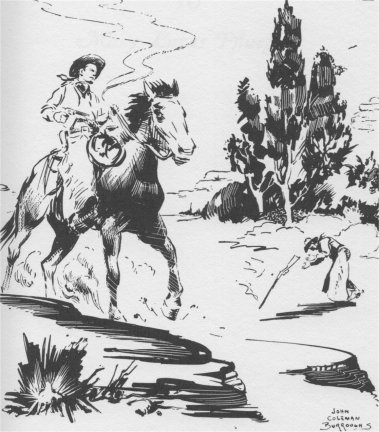

<>
<>Dude ranch foreman Cory Blaine commented on a newspaper article about the recent murder of Ole Gunderstrom. “They haven’t found that fellow Mason yet. He’s been missing for three weeks—disappeared the day after the murder.”
<>Dude ranch foreman Cory Blaine commented on a newspaper article about the recent murder of Ole Gunderstrom. “They haven’t found that fellow Mason yet. He’s been missing for three weeks—disappeared the day after the murder.”
<>
<>When dude ranch visitor Dora Crowell said she heard Ole was shot through the heart, Blaine corrected her, saying Ole was shot “between the eyes.” That gave sheriff-in-disguise Buck Mason his first clue that Blaine was the murderer, since the detail that Ole was shot “between the eyes” didn’t appear in the newspaper article.
<>When dude ranch visitor Dora Crowell said she heard Ole was shot through the heart, Blaine corrected her, saying Ole was shot “between the eyes.” That gave sheriff-in-disguise Buck Mason his first clue that Blaine was the murderer, since the detail that Ole was shot “between the eyes” didn’t appear in the newspaper article.
Lafayette
Smith meets Lady Barbara
<>
<>American geologist Lafayette Smith came face-to-face in Africa with a British woman he had never met … but he knew her name immediately. “You’re Lady Barbara Collis!” he exclaimed. “How did you know?” she asked. “Have you been searching for me?” “No,” he said, “but when I passed through London the papers were full of the story of your flight and your disappearance—pictures and things.”
<>American geologist Lafayette Smith came face-to-face in Africa with a British woman he had never met … but he knew her name immediately. “You’re Lady Barbara Collis!” he exclaimed. “How did you know?” she asked. “Have you been searching for me?” “No,” he said, “but when I passed through London the papers were full of the story of your flight and your disappearance—pictures and things.”
<>
<>Another character in the story had a newspaper background. Dominic Capietro explained: “I am a slave raider—rather a remarkable vocation for a university graduate and the former editor of a successful newspaper.” Mussolini’s rise to power in Italy had caused Capietro to abandon his newspaper and flee to Africa. “You see,” he explained, “my newspaper was anti-Fascist.”
<>Another character in the story had a newspaper background. Dominic Capietro explained: “I am a slave raider—rather a remarkable vocation for a university graduate and the former editor of a successful newspaper.” Mussolini’s rise to power in Italy had caused Capietro to abandon his newspaper and flee to Africa. “You see,” he explained, “my newspaper was anti-Fascist.”
Big
city crime reporters
<>
In one of ERB’s short mystery stories, city newspapers were already making “capital” from a society murder case, when Inspector Muldoon first arrived at the crime scene. “You’d think these reporters were planted around beforehand in the hope that someone was going to be murdered,” he lamented. “They know ‘all about it’ before the police.”
In one of ERB’s short mystery stories, city newspapers were already making “capital” from a society murder case, when Inspector Muldoon first arrived at the crime scene. “You’d think these reporters were planted around beforehand in the hope that someone was going to be murdered,” he lamented. “They know ‘all about it’ before the police.”
Hollywood
papers
<>
<>The story
includes four references to Los Angeles and Hollywood newspapers.
First, cast
as the male lead in a jungle film, Stanley Obroski is thrilled at first
meeting
his co-star, Naomi Madison. “Why, before I ever dreamed of you,” he
told her,
“I used to go see everything you were in. I got an album full of your
pictures
I cut out of movie magazines and newspapers.”
<>
<>Then, when Tarzan arrived at the Los Angeles train station in the story’s final chapter, he watched as, “Cameras clicked and whirred for local papers, for news syndicates, for news reels” as reporters, and special correspondents pressed forward to cover actresss Balza’s return to Hollywood.
<>Then, when Tarzan arrived at the Los Angeles train station in the story’s final chapter, he watched as, “Cameras clicked and whirred for local papers, for news syndicates, for news reels” as reporters, and special correspondents pressed forward to cover actresss Balza’s return to Hollywood.
<>
<>Later, Reece, a young con artist who attached himself to Tarzan, spotted a friend. “Say, I see you’re going to work for Abe Potkin, doing Tarzan,” Reece mention to the man, who then asked, “Who told you that?” Reece explained, “It’s in Louella Parsons column in the Examiner.”
<>Later, Reece, a young con artist who attached himself to Tarzan, spotted a friend. “Say, I see you’re going to work for Abe Potkin, doing Tarzan,” Reece mention to the man, who then asked, “Who told you that?” Reece explained, “It’s in Louella Parsons column in the Examiner.”
<>
<>Later that day, Tarzan was looking through the afternoon paper. He saw the following banner across the top of the theatrical page: CYRIL WAYNE TO DO TARZAN. FAMOUS ADAGIO DANCER SIGNED BY PROMINENT PICTURES FOR STELLAR ROLE IN FORTHCOMING PRODUCTION.
<>Later that day, Tarzan was looking through the afternoon paper. He saw the following banner across the top of the theatrical page: CYRIL WAYNE TO DO TARZAN. FAMOUS ADAGIO DANCER SIGNED BY PROMINENT PICTURES FOR STELLAR ROLE IN FORTHCOMING PRODUCTION.
The
curse of celebrities
<>
<>In the opening chapter, Lady Greystoke was having lunch in London with Kitty Krause and her new husband, Alexis Sborov. “Why, Kitty,” Jane said, “it must be a year since I have heard anything of you, except what I have read in the newspapers.” Kitty responded, “Yes, indeed. We have a whole book filled with newspaper clippings—some of them were horrid.” Sborov added, “But you kept them all.” Kitty responded, “Oh, well. I suppose one must pay for fame and position; but these newspaper people can be so terribly horrid.”
<>In the opening chapter, Lady Greystoke was having lunch in London with Kitty Krause and her new husband, Alexis Sborov. “Why, Kitty,” Jane said, “it must be a year since I have heard anything of you, except what I have read in the newspapers.” Kitty responded, “Yes, indeed. We have a whole book filled with newspaper clippings—some of them were horrid.” Sborov added, “But you kept them all.” Kitty responded, “Oh, well. I suppose one must pay for fame and position; but these newspaper people can be so terribly horrid.”
Elmer’s
death revealed
<>
After Pat Morgan and ERB found the frozen Elmer in Siberia and restored the caveman to life, they brought him to London. Unable to cope with modern civilization, Elmer re-froze himself. While lunching together one day, ERB and Pat Morgan learned from “an announcement in a screaming banner spread across the top of the front page of the Herald and Express,” that Elmer’s body had been found.
After Pat Morgan and ERB found the frozen Elmer in Siberia and restored the caveman to life, they brought him to London. Unable to cope with modern civilization, Elmer re-froze himself. While lunching together one day, ERB and Pat Morgan learned from “an announcement in a screaming banner spread across the top of the front page of the Herald and Express,” that Elmer’s body had been found.
Boxing
News
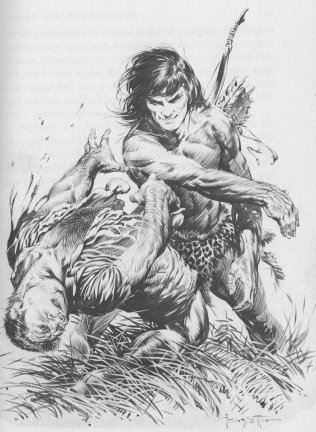

<>
<>After “One-Punch” Mullargan’s opponent was counted out, sports-writers converged on the ring to interview the new Heavyweight Champion. “Jittery news-commentators bawled the epochal tidings to a waiting world.” Ten days later, on the deck of a ship taking Mullargan to Africa on vacation, “Sports-writers and camera-men milled around the champion on the deck of the ship. Bulbs flashed; shutters clicked; reporters shot questions.” When a girl asked Mullargan for an autograph, a Daily News man asked, “When did he learn to write?”
<>After “One-Punch” Mullargan’s opponent was counted out, sports-writers converged on the ring to interview the new Heavyweight Champion. “Jittery news-commentators bawled the epochal tidings to a waiting world.” Ten days later, on the deck of a ship taking Mullargan to Africa on vacation, “Sports-writers and camera-men milled around the champion on the deck of the ship. Bulbs flashed; shutters clicked; reporters shot questions.” When a girl asked Mullargan for an autograph, a Daily News man asked, “When did he learn to write?”
<>
<>In Africa, Mullargan envisioned his big game hunting would bring him lots of publicity in the states. “I’ll sure give them newspaper bums somep’n to write about when I get home,” he predicted. “I’ll have one of the photographer bums take my pitcher settin’ on top of a thousand head—all kinds. That’ll get in every newspaper in the U.S.”
<>In Africa, Mullargan envisioned his big game hunting would bring him lots of publicity in the states. “I’ll sure give them newspaper bums somep’n to write about when I get home,” he predicted. “I’ll have one of the photographer bums take my pitcher settin’ on top of a thousand head—all kinds. That’ll get in every newspaper in the U.S.”
The
Classified Section
<>
Scanning the want ads, looking for a job, Cyril Fortesque’s eyes stopped at the following: “WANTED: Men without family ties to join scientific expedition to be gone for two years; need some with scientific and some seafaring experience; must be in excellent physical condition; misogynists preferred.”
Scanning the want ads, looking for a job, Cyril Fortesque’s eyes stopped at the following: “WANTED: Men without family ties to join scientific expedition to be gone for two years; need some with scientific and some seafaring experience; must be in excellent physical condition; misogynists preferred.”
<>
<>Myron Perry came upon the same ad, but not because he needed a job. “He was merely following a custom of long standing, for in the Classified Section of the Sunday paper he found humor, pathos, tragedy—the full gamut of human emotions, avarice, greed, faith, charity, hope, despair, and there was always an undercurrent of mystery; as for example, an ad that read, “Mabel: Come home; all is forgiven. Mother,” might mean that Mabel was forgiven, or it might mean that it was safe for ‘Looey the Louse’ to come out of hiding.”
<>Myron Perry came upon the same ad, but not because he needed a job. “He was merely following a custom of long standing, for in the Classified Section of the Sunday paper he found humor, pathos, tragedy—the full gamut of human emotions, avarice, greed, faith, charity, hope, despair, and there was always an undercurrent of mystery; as for example, an ad that read, “Mabel: Come home; all is forgiven. Mother,” might mean that Mabel was forgiven, or it might mean that it was safe for ‘Looey the Louse’ to come out of hiding.”
Newspaper
article leads to fateful wager
<>
<>Francis Bolton-Chilton and Colin T. Randolph, Jr., were sitting in their London club one day reading their newspapers, when Randolph came across an article about a native boy who had been captured by a band of baboons. Randolph declared that if a boy like that could survive in the wild alone, so could he. Bolton-Chilton bet Randolph a thousand pounds that he couldn’t do it. Randolph accepted and soon was on his way to Africa.
<>Francis Bolton-Chilton and Colin T. Randolph, Jr., were sitting in their London club one day reading their newspapers, when Randolph came across an article about a native boy who had been captured by a band of baboons. Randolph declared that if a boy like that could survive in the wild alone, so could he. Bolton-Chilton bet Randolph a thousand pounds that he couldn’t do it. Randolph accepted and soon was on his way to Africa.
The
strange story of Loto-Betty Callwell
<>
<>On Venus, a captive Carson Napier was taken before Loto-El-Ho-Ganja, head of the church of Brokol. Carson noticed that she didn’t look like a Brokol, but rather like a human woman. When Carson mentioned that he was from “The United States of America,” she wrinkled her brows as in thought. “A strange, puzzled expression came into her eyes. She seemed to be straining to bring some forgotten memory from the deepest recesses of her mind, but presently she shook her head wearily.”
<>On Venus, a captive Carson Napier was taken before Loto-El-Ho-Ganja, head of the church of Brokol. Carson noticed that she didn’t look like a Brokol, but rather like a human woman. When Carson mentioned that he was from “The United States of America,” she wrinkled her brows as in thought. “A strange, puzzled expression came into her eyes. She seemed to be straining to bring some forgotten memory from the deepest recesses of her mind, but presently she shook her head wearily.”
She told
Carson, “In the back of my mind are a million
memories, but most of them are only vague and fragmentary. I try very
hard to
piece them together or to build them into recognizable wholes, but I
never
can.”
<>
<>It’s unknown how she came to be a living goddess among these alien people. When Carson mentioned New York, she responded, “It seems just as though I had heard that name before … New York—New York—New York.” Suddenly, she yelled, “Betty! Betty! Betty! I’m getting it! … Brooklyn! Now I have it! Brooklyn.” Then she swooned. In the morning, Carson noticed that Loto had disappeared.
<>It’s unknown how she came to be a living goddess among these alien people. When Carson mentioned New York, she responded, “It seems just as though I had heard that name before … New York—New York—New York.” Suddenly, she yelled, “Betty! Betty! Betty! I’m getting it! … Brooklyn! Now I have it! Brooklyn.” Then she swooned. In the morning, Carson noticed that Loto had disappeared.
<>
<>ERB then halted the narrative to provide some unusual information. “Editor’s Note: Not that it has any bearing on this story, but just as an example of a remarkable coincidence, I want to reproduce here a news item that appeared in the daily press recently.”
<>ERB then halted the narrative to provide some unusual information. “Editor’s Note: Not that it has any bearing on this story, but just as an example of a remarkable coincidence, I want to reproduce here a news item that appeared in the daily press recently.”
<>
<>“Brooklyn, Sept. 24. Special— Correspondence. The body of Betty Callwell, who disappeared twenty-five years ago, was found in the alley back of her former home here early this morning. The preservation of the body was remarkable, as Miss Callwell must have been dead for twenty-five years. Friends who viewed the body insist that it did not look a day older than when she disappeared. The police fear foul play and are investigating.”
<>“Brooklyn, Sept. 24. Special— Correspondence. The body of Betty Callwell, who disappeared twenty-five years ago, was found in the alley back of her former home here early this morning. The preservation of the body was remarkable, as Miss Callwell must have been dead for twenty-five years. Friends who viewed the body insist that it did not look a day older than when she disappeared. The police fear foul play and are investigating.”
Spies
steal restaurant menus
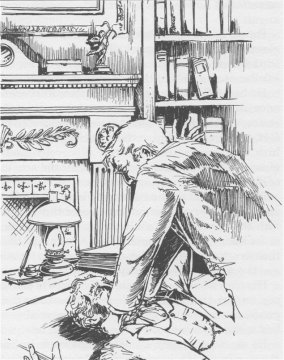
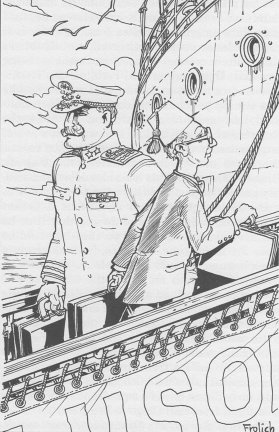


<>
<>This Burroughs short story, written in 1940, begins with the doddy Abner Dinnwiddie on the liner Lusonia bound for a Hawaiian vacation. Also on the ship are Peter and Sonia (aka Miss Doughly), a couple of bungling foreign spies who mistakenly believe Abner is carrying blue prints and specifications of the U.S. Navy’s new bomb site.
<>This Burroughs short story, written in 1940, begins with the doddy Abner Dinnwiddie on the liner Lusonia bound for a Hawaiian vacation. Also on the ship are Peter and Sonia (aka Miss Doughly), a couple of bungling foreign spies who mistakenly believe Abner is carrying blue prints and specifications of the U.S. Navy’s new bomb site.
<>
<>Confronting Dinnwiddie in his stateroom, the spies demand that he turn over his brief case. The scared American immediately complies. “If you don’t want this in the papers,” Peter told him, “you will keep your mouth shut and say that you lost the papers overboard.”
<>Confronting Dinnwiddie in his stateroom, the spies demand that he turn over his brief case. The scared American immediately complies. “If you don’t want this in the papers,” Peter told him, “you will keep your mouth shut and say that you lost the papers overboard.”
<>
<>The story concludes with the following excerpt from a Honolulu newspaper. “Through an error in the Lusonia’s printed passenger list and the very clever work of Mr. Abner Dinnwiddie of Utropolis, Kansas, the police yesterday nabbed three international crooks and spies and believe that they have broken up a spy ring that the F.B.I. has been investigating for several months. Mr. Dinnwiddie is a prominent Kansas business man and a well known Shriner.”
<>The story concludes with the following excerpt from a Honolulu newspaper. “Through an error in the Lusonia’s printed passenger list and the very clever work of Mr. Abner Dinnwiddie of Utropolis, Kansas, the police yesterday nabbed three international crooks and spies and believe that they have broken up a spy ring that the F.B.I. has been investigating for several months. Mr. Dinnwiddie is a prominent Kansas business man and a well known Shriner.”
<>
<>It turns out that a mistake on the Lusonia’s passenger list caused the spies to believe Dinnwiddie had the secret information. Actually, all that was in his brief case was Dinnwiddie’s collection of hotel and restaurant menus.
<>It turns out that a mistake on the Lusonia’s passenger list caused the spies to believe Dinnwiddie had the secret information. Actually, all that was in his brief case was Dinnwiddie’s collection of hotel and restaurant menus.
—The
End—
ALAN'S MANY
ERBzine APPEARANCES
www.erbzine.com/hanson
BILL HILLMAN
Visit our thousands of other sites at:
BILL and SUE-ON HILLMAN ECLECTIC STUDIO
ERB Text, ERB Images and Tarzan® John Carter® Priness of Mars® are ©Edgar Rice Burroughs, Inc.- All Rights Reserved.
All Original Work ©1996-2025 by Bill Hillman and/or Contributing Authors/Owners
No part of this web site may be reproduced without permission from the respective owners
